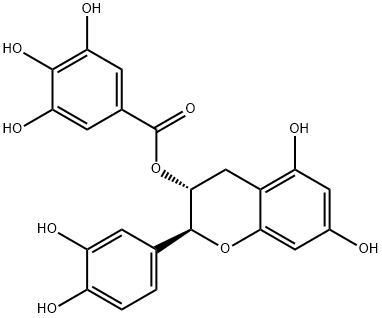(-)-CATECHIN
Synonym(s):(−)-trans-3,3′,4′,5,7-Pentahydroxyflavane;(2S,3R)-2-(3,4-Dihydroxyphenyl)-3,4-dihydro-1(2H)-benzopyran-3,5,7-triol
- CAS NO.:18829-70-4
- Empirical Formula: C15H14O6
- Molecular Weight: 290.27
- MDL number: MFCD00135997
- EINECS: 242-611-7
- SAFETY DATA SHEET (SDS)
- Update Date: 2024-11-19 23:02:33

What is (-)-CATECHIN?
The Uses of (-)-CATECHIN
A natural phenol antioxidant plant secondary metabolite.
The Uses of (-)-CATECHIN
In dyeing and tanning.
The Uses of (-)-CATECHIN
(-)-Catechin has been used:
- to test its binding affinity towards estrogen receptor
- as a reference standard in high-performance liquid chromatography for quantification of polyphenols from plant extracts (HPLC)
- as a reference standard in kinetic studies to quantify antioxidants from Iranian green tea leaves
What are the applications of Application
(?)-Catechin is a natural phenol antioxidant
Definition
ChEBI: (-)-catechin is the (-)-enantiomer of catechin. It has a role as a metabolite. It is an enantiomer of a (+)-catechin.
General Description
This substance is a primary reference substance with assigned absolute purity (considering chromatographic purity, water, residual solvents, inorganic impurities). The exact value can be found on the certificate. Produced by PhytoLab GmbH & Co. KG
Biochem/physiol Actions
Catechins have wide biological functionality. They induce antiviral and anticancer activities. Catechins also play a key role in regulating carbohydrate and lipid metabolism. It prevents fat accumulation.
Properties of (-)-CATECHIN
| Melting point: | 93-96°; 175-177° when anhydr |
| Boiling point: | 630.4±55.0 °C(Predicted) |
| alpha | D -16.8° |
| Density | 1.593±0.06 g/cm3(Predicted) |
| storage temp. | 2-8°C |
| solubility | DMF: 25 mg/ml; DMSO: 15 mg/ml; Ethanol: 5 mg/ml; PBS (pH 7.2): 1 mg/ml |
| form | A crystalline solid |
| pka | 9.54±0.10(Predicted) |
| color | White to off-white |
| CAS DataBase Reference | 18829-70-4(CAS DataBase Reference) |
Safety information for (-)-CATECHIN
| Signal word | Warning |
| Pictogram(s) |
 Exclamation Mark Irritant GHS07 |
| GHS Hazard Statements |
H315:Skin corrosion/irritation H319:Serious eye damage/eye irritation H335:Specific target organ toxicity, single exposure;Respiratory tract irritation |
| Precautionary Statement Codes |
P261:Avoid breathing dust/fume/gas/mist/vapours/spray. P264:Wash hands thoroughly after handling. P264:Wash skin thouroughly after handling. P271:Use only outdoors or in a well-ventilated area. P280:Wear protective gloves/protective clothing/eye protection/face protection. P302+P352:IF ON SKIN: wash with plenty of soap and water. P305+P351+P338:IF IN EYES: Rinse cautiously with water for several minutes. Remove contact lenses, if present and easy to do. Continuerinsing. |
Computed Descriptors for (-)-CATECHIN
New Products
4-Fluorophenylacetic acid 4-Methylphenylacetic acid N-Boc-D-alaninol N-BOC-D/L-ALANINOL Tert-butyl bis(2-chloroethyl)carbamate 3-Morpholino-1-(4-nitrophenyl)-5,6-dihydropyridin- 2(1H)-one Furan-2,5-Dicarboxylic Acid Tropic acid S-2-CHLORO PROPIONIC ACID ETHYL ISOCYANOACETATE 2-Bromo-1,3-Bis(Dimethylamino)Trimethinium Hexafluorophosphate (6-METHYL-[1,3]DITHIOLO[4,5-b]QUINOXALIN-2-ONE INDAZOLE-3-CARBOXYLIC ACID 4-IODO BENZOIC ACID (2-Hydroxyphenyl)acetonitrile 4-Bromopyrazole 5,6-Dimethoxyindanone 2-(Cyanocyclohexyl)acetic acid 4-methoxy-3,5-dinitropyridine 2-aminopropyl benzoate hydrochloride 1-(4-(aminomethyl)benzyl)urea hydrochloride diethyl 2-(2-((tertbutoxycarbonyl)amino) ethyl)malonate tert-butyl 4- (ureidomethyl)benzylcarbamate Ethyl-2-chloro((4-methoxyphenyl)hydrazono)acetateRelated products of tetrahydrofuran








You may like
-
 (−)-Catechin, ≥97% (HPLC), from green tea CAS 18829-70-4View Details
(−)-Catechin, ≥97% (HPLC), from green tea CAS 18829-70-4View Details
18829-70-4 -
 (−)-Catechin CAS 18829-70-4View Details
(−)-Catechin CAS 18829-70-4View Details
18829-70-4 -
 (−)-Catechin CAS 18829-70-4View Details
(−)-Catechin CAS 18829-70-4View Details
18829-70-4 -
 1975-50-4 98%View Details
1975-50-4 98%View Details
1975-50-4 -
 2-HYDROXY BENZYL ALCOHOL 98%View Details
2-HYDROXY BENZYL ALCOHOL 98%View Details
90-01-7 -
 2-Chloro-1,3-Bis(Dimethylamino)Trimethinium Hexafluorophosphate 221615-75-4 98%View Details
2-Chloro-1,3-Bis(Dimethylamino)Trimethinium Hexafluorophosphate 221615-75-4 98%View Details
221615-75-4 -
 14714-50-2 (2-Hydroxyphenyl)acetonitrile 98+View Details
14714-50-2 (2-Hydroxyphenyl)acetonitrile 98+View Details
14714-50-2 -
 118753-70-1 98+View Details
118753-70-1 98+View Details
118753-70-1
Statement: All products displayed on this website are only used for non medical purposes such as industrial applications or scientific research, and cannot be used for clinical diagnosis or treatment of humans or animals. They are not medicinal or edible.